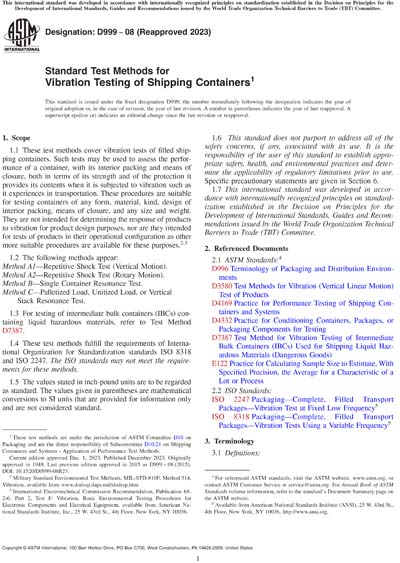Most recent
ASTM D999-08(2023)
Standard Test Methods for Vibration Testing of Shipping Containers
1.1 These test methods cover vibration tests of filled shipping containers. Such tests may be used to assess the performance of a container, with its interior packing and means of closure, both in terms of its strength and of the protection it provides its contents when it is subjected to vibration such as it experiences in transportation. These procedures are suitable for testing containers of any form, material, kind, design of interior packing, means of closure, and any size and weight. They are not intended for determining the response of products to vibration for product design purposes, nor are they intended for tests of products in their operational configuration as other more suitable procedures are available for these purposes.2,3
1.2 The following methods appear:
Method A1—Repetitive Shock Test (Vertical Motion).
Method A2—Repetitive Shock Test (Rotary Motion).
Method B—Single Container Resonance Test.
Method C—Palletized Load, Unitized Load, or Vertical
Stack Resonance Test.
1.3 For testing of intermediate bulk containers (IBCs) containing liquid hazardous materials, refer to Test Method D7387.
1.4 These test methods fulfill the requirements of International Organization for Standardization standards ISO 8318 and ISO 2247. The ISO standards may not meet the requirements for these methods.
1.5 The values stated in inch-pound units are to be regarded as standard. The values given in parentheses are mathematical conversions to SI units that are provided for information only and are not considered standard.
1.6 This standard does not purport to address all of the safety concerns, if any, associated with its use. It is the responsibility of the user of this standard to establish appropriate safety, health, and environmental practices and determine the applicability of regulatory limitations prior to use. Specific precautionary statements are given in Section 6.
1.7 This international standard was developed in accordance with internationally recognized principles on standardization established in the Decision on Principles for the Development of International Standards, Guides and Recommendations issued by the World Trade Organization Technical Barriers to Trade (TBT) Committee.
ASTM International [astm]

